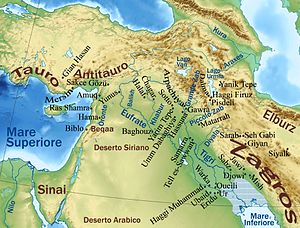Yarim Tepe

Yarim Tepe is an archaeological site of an early farming settlement that goes back to about 6000 BC, located in the Sinjar valley some 7km southwest from the town of Tal Afar in northern Iraq. The site consists of several hills reflecting the development of the Hassuna culture, and then of the Halaf and Ubaid cultures.
The settlement was investigated between 1969 and 1976 by the Soviet archaeological expedition under the leadership of Rauf Munchaev and Nikolai Merpert.[1]
Yarim Tepe excavations
Yarim Tepe I
The hill known as Yarim-Tepe I belongs to Hassuna culture. The high central, oval-shaped core is 80 meters long and 30 meters wide. Some objects found here are reminiscent of those of Tureng Tepe in Iran.
13 building layers are found here, reflecting the main stages of this culture. The cultural level is 6.5 m deep. There are more than 1500 rectangular furnaces and ceramic ovens used for cooking. The earliest known kiln, dating to around 6000 BC, was found here.[2]
The village had courtyards and small streets with rectangular mud-brick buildings. There were also public granaries. Burials of children in vessels were found, as well as various stone utensils, such as stone crushers, and hacksaws.
The findings also include ceramic vases, female clay figurines, and other items.
Metal items were also found, such as a lead bracelet, copper beads, as well as copper ore, which represents some of the oldest metallurgy in Mesopotamia.[3]
Bovine bones were also found.
Yarim Tepe II
Yarim Tepe II is a settlement of the Halafian culture, belonging to the fifth millennium BC. The cultural level is 7 m deep, and it consists of ten structural horizons. The bones of both domestic and wild animals were found, among them the bones of sheep, ox, goats, and pigs.
Ceramic figured vessels in the shape of elephants and women were found among other pottery. Some ceramic containers have pictures of fish, birds, gazelles and other animals on them.
Some pendant seals were also discovered, including a very old copper seal.
The burial customs included cremations, and the burials of skulls[4]
Kul Tepe (Iraq)
Kul Tepe (Iraq) is a related site located about 6km due west from Yarim tepe. Two mounds there (Kultepe I, and Kultepe II) have been excavated. The lowest level of Kultepe I contains material of Sotto type (from nearby Tell Sotto), and above it there is archaic Hassuna materials.[5]
The lowest level also contains three high quality marble vessels, with parallels at Tell es-Sawwan and Umm Dabaghiyah.
See also
Notes
- ^ Merpert N. Ya. 1993. The archaic phase of the Hassuna culture. In N. Yoffee, J. J. Clark (eds.), Early stages in the evolution of Mesopotamian civilization. Soviet excavations in Northern Iraq. The University of Arizona Press, Arizona: 115–127
- ^ Piotr Bienkowski; Alan Millard (15 April 2010). Dictionary of the Ancient Near East. University of Pennsylvania Press. p. 233. ISBN 978-0-8122-2115-2.
- ^ Yarim Tepe thefreedictionary.com
- ^ Yarim Tepe thefreedictionary.com
- ^ Charles Keith Maisels, Early Civilizations of the Old World: The Formative Histories of Egypt, The Levant, Mesopotamia, India and China. Routledge, 2003 ISBN 1134837313 p128
Bibliography
- Natalia Petrova, A technological study of Hassuna culture ceramics (Yarim Tepe I settlement). Documenta Praehistorica XXXIX (2012)
- 1993. Yarim Tepe I. In N. Yoffee, J. J. Clark (eds.), Early stages in the evolution of Mesopotamian civilization. Soviet excavations in Northern Iraq. The University of Arizona Press, Arizona: 73–114.
- Merpert N. Ya. 1993. The archaic phase of the Hassuna culture. In N. Yoffee, J. J. Clark (eds.), Early stages in the evolution of Mesopotamian civilization. Soviet excavations in Northern Iraq. The University of Arizona Press, Arizona: 115–127.
- Munchaev R. M., Merpert N. Ya.1981. Earliest Agricultural Settlements of Northern Mesopotamia. Nauka Press. Moscow. (in Russian)
- Merpert, Nikolai I., and Rauf M. Munchaev. 1987. “The Earliest Levels at Yarim Tepe I and Yarim Tepe II in Northern Iraq.” Iraq 49:1–37
- Merpert, Nikolai I., and Rauf M. Munchaev. 1973. “Early Agricultural Settlement in the Sinjar Plain, Northern Iraq.” Iraq 35:97–113
